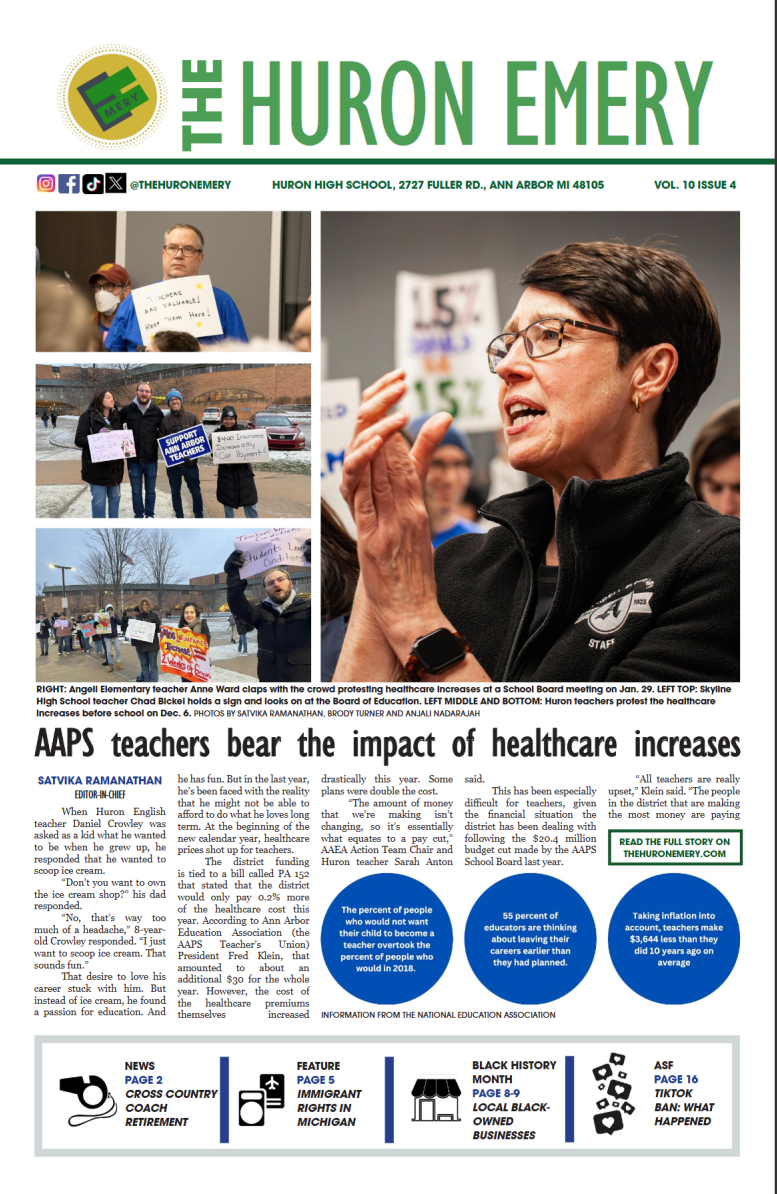The Unsheltered Truth: Youth Homelessness in A2
February 24, 2023
Hidden in plain sight — sometimes you see them in parked cars. Sometimes you see them on park benches. You even see them on the streets of our very own town. Youth homelessness is on the rise.
Established in 1987, the McKinney-Vento Act is a federally funded program that’s main purpose is to assist students and families experiencing homelessness in order to support the students’ education. Each school district, in not only Michigan, but across the entirety of the United States has at least one McKinney-Vento representative to manage the distribution of the Act’s resources across the school district to students in need. Alicia Maylone, AAPS’ very own liaison and coordinator for the McKinney-Vento act, has changed the lives and advanced the education of countless youth across the Ann Arbor community.
Maylone was asked about the most common causes of homelessness that she’s experienced in her time working with AAPS, she said.
“ For families experiencing homelessness, there are many underlying circumstances that can lead to having some housing instability,” Maylone said. “An example would be family dynamics. If young people aren’t getting along at home, it can lead to them leaving home or being put out of home.”
There are a wide, diverse range of factors that can contribute to families experiencing homelessness, but many revolve around difficulties with income and lack of affordable housing in the area.
Coach Waleed Samaha has worked at Huron for a long time, but his most recent position has been General Education Social Worker, which consists of working with students who are transitioning to and returning from support programs in the district.
“Is it a bigger issue than we think? Yes,” Samaha said. “Is it adequately resourced? I think in Ann Arbor, we’re very aware. There’s a level of consciousness where we understand every child needs some kind of support, some kids need more, some kids need less. Do I think it’s overlooked? I don’t necessarily think it’s overlooked, it’s kind of like [homelessness] is there and it’s not always as present in our minds.”
According to PayScale, Ann Arbor’s cost of living is not only five percent above the national average, but also 16 percent above the national average for the cost of housing — per 2022 statistics. Ann Arbor is an objectively expensive place to live, and that makes living and maintaining stable housing a more difficult task, let alone supporting a family and children. The pandemic was even more detrimental to those struggling financially, which according to Maylone skyrocketed the homelessness numbers in our community.
“Especially after the pandemic, families can fall further behind and have difficulty catching up with current inflation and other challenges as well. So it really has become what was already a difficult situation has just really become an even greater challenge for families especially in Washtenaw County, where we have like the 98th highest rental rate, or something like that, in the state.” said Maylone.
With an estimated 2,800 people experiencing homelessness in Washtenaw County, school counselors, social workers and teachers are doing everything they can to help support their situation, whether it be through support programs or a simple helping hand.
“Ann Arbor is a really expensive place to live in,” Samaha said. “So for a lot of times, it’s not like people come to Ann Arbor to seek homeless support or anything like that, it’s not like a haven [for homelessness].”
With the increased difficulty of landing stable housing in Ann Arbor, there are a lot of resources that most would take for granted.
Maylone then commented more on what the McKinney-Vento Act does for students in need.
“If there are challenges to enrolling because of missing paperwork, or challenges, [continuing] attending school consistently because of transportation, or need for other resources, then those are addressed.” said Maylone.
“We try to ease that transition for them and we try to take things off of their shoulders,” Samaha said. “Worrying about transportation, worrying about what they’re going to eat, if they’re going to eat, when they’re going to eat, and making sure they have the school materials that they need — because none of this is their fault… They’re kids, they’re counting on adults, the same way you do, and the same way I did, and the same way my child counts on me. So, to no fault of their own, they end up in a circumstance where they really need some support.”
For a student experiencing homelessness for any reason, changes in the quality of education can be drastically damaging. Maylone also said that for the average student dealing with housing instability would result in them moving around three times per year. This could lead to a student having to switch schools or even school districts entirely, which heavily disrupts the progress that a student can realistically make in a school year. Even moving schools one time in a calendar year can be regressive to keeping up with classwork, but having to move around three times in one calendar year could severely affect not only the students’ academic performance, but their motivation in the classroom as well.
“It kind of gets to that point of feeling like it’s so much to overcome, is it really worth it? So, that leads to not only difficulties and changes in school, but also learning loss. If a school change does occur, education is set back by [an equivalent of] six months — is the statistical understanding. And then the dropout rate actually for those who experience homelessness is significantly higher, ” said Maylone.
But Samaha’s philosophy in supporting students in need is derived from ignoring that loss of motivation in the classroom, and holding every student accountable for their work to preserve what’s best for a student, or as to not — as Samaha says — “cripple them”.
“One thing I really try to stress with kids is you can let your circumstances impact your choices, or you can let your choices impact your circumstances,” Samaha said. “Or you can sit back and say ‘I’m homeless so life sucks, so I’m not going to try hard in school. I’m not going to do things or try things because life sucks.’ and you can use that and it’ll cripple you, and your circumstances will inevitably either stay the same or get worse.”
The social aspect of being homeless as a child or teenager is arguably one of the most challenging parts of experiencing homelessness. Samaha believes that promoting the shared values of every student at Huron, is key to being as empathic and understanding of those going through hard times in our school.
“Every single child in this building wants the same things. Everybody here wants to be accepted, everybody here wants to be supported, everybody here wants the opportunity to learn and grow, and everybody here wants a positive teenage life experience. Whether it be through sports, or clubs, or activities, or social opportunities, or just friendships at school — you all want the same things.”
“Kids that are experiencing homelessness, don’t want to be labeled that way. They really want to come to school and just be like other kids.” said Samaha.
In Maylone’s experience, the social transition of students experiencing homelessness is congruent with their basic needs being met.
“If a young person is still able to get to school, just how much time and space do they really have to sometimes participate in the full school experience or community experience?” Maylone said.
Missing just a week of school can severely backlog the average students’ workload, but having to juggle homelessness, and still maintaining a social life on top of all of that is a burden most couldn’t even fathom. According to both Maylone and Samaha, there are some students who are separated from their families as a byproduct of being homeless. Some cases that both AAPS and the McKinney-Vento Act have to deal with involve students having to be disconnected from their families to prioritize safety for the child.
“The majority of students who are considered McKinney-Vento eligible are with families experiencing homelessness. But then there are also students who are considered ‘unaccompanied’ or [are] not staying with the legal guardian,” Maylone said.
Maylone then expanded on what requirements a student’s situation has to meet to qualify to receive help from the McKinney-Vento Act.
“So there’s specific living situations and those are typically either staying doubled up or couch-surfing — staying in someone’s home, a temporary situation, a friend or a family member, or transitioning between multiple homes staying at other folks’ homes.” Maylone said.
Staying in a situation not meant for human inhabitation, like sleeping in a vehicle or going to a hospital or police station because they have nowhere else to go are both examples of the nightly living situations that students may be experiencing.
Luckily for our community, Ann Arbor has a level of awareness much greater than that of others. Maylone attributes that to McKinney-Vento’s influence.
“I think awareness has grown, just in the last decade or so in this community,” said Maylone. “There’s been more awareness of the difficulties in securing stable housing, and for the impacts of experiencing transitions in your living situation, [may] also [be] impacting students at school.”
Samaha seemed to agree.
“Is it a bigger issue than we think? Yes,” Samaha said. “Is it adequately resourced? I think in Ann Arbor, we’re very aware. There’s a level of consciousness where we understand every child needs some kind of support, some kids need more, some kids need less. Do I think it’s overlooked? I don’t necessarily think it’s overlooked, it’s kind of like [homelessness] is there and it’s not always as present in our minds.”
We’re all in classes with kids that are homeless, eating lunch in the cafeteria with kids that are homeless, participating in clubs and teams and activities with kids that are homeless.
“I’m not saying that there are 500 homeless kids in the building, there are enough kids that are experiencing homelessness at various times in the school year, where it may be from 10-20 [kids] at a time in our building. And yet, you wouldn’t know,” Samaha said.
But what can we do to help? The main piece of advice that both Maylone and Samaha offered was to be kind, to be courteous, and to be accepting of all regardless of the stability of their housing.
“Just be nice to everyone,” Samaha said. “You really never know what someone else is going through.”










